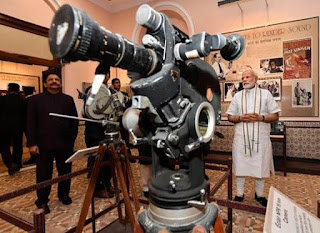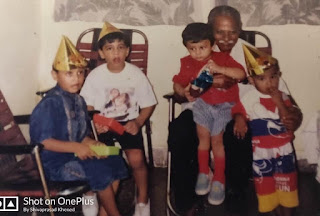Sunday 13 October 2019
The Great Indian Democracy
Mega Science Projects: Quest for understanding the unknown, micro to macro universe. (2 Days seminar at the Nehru Science Centre 8th and 9th May 2019)
Dr Gagandeep Kang, FRS
Dr Gagandeep Kang, FRS.
Heritage on Wheels: Vintage Car Exhibition at Nehru Science Centre, Mumbai
The Silicon Valley : Dissent and Treachery
Exploring Brain & Mental Health : An exhibition from the Harvard School of Medicine (McLain Hospital) USA.
Piggly Wiggly : Revolutionary Innovation in Retail Market
International Year of the Periodic Table of Chemical Elements (IYPT2019) : Commemorating it’s sesquicentennial year.
Makar Sankrati : Another opportunity to “ring out the old, and ring in the new”
Makar Sankrati : Another opportunity to “ring out the old, and ring in the new”
“Ring out the old, ring in the new, Ring, happy bells, across the snow: The year is going, let him go; Ring out the false, ring in the true.” - Alfred Tennyson.
It has been a week since the tragic death of my brother in law, yet my wife has continued to be in a state of shock and was unable to move on, despite my best of efforts. The shock of her brothers death has already started taking a toll on her health and my wife is not able to understand that she must come out of the shock as early as possible else. No amount of my love, affection and counselling is helping her to try and come back to normalcy and start taking food normally. Like her brother she too is a diabetic patient and therefore I knew that indifference towards taking food timely will have a consequence on her health and I had to act fast to try and bring her back to normalcy as early as possible at-least in terms of taking timely food and medicine. The Makar Sankranti, which is celebrated as a New Year’s Day in Karnataka and many other parts of India, helped me in convincing my wife to let go of the past by quoting Alfred Tennyson “ring out the old, and ring in the new”. I spoke to her of the importance of the Makara Sankranti and how and why this festival is quite important for Indians and that in many parts of India this festival is celebrated as a new year.
Makar Sankranti (Sankranti meaning ‘movement) is the first major Hindu festival in the Gregorian calendar, celebrated with much fervor across most parts of India. This auspicious day - the harvest day - marks the transition of the Sun into the zodiac Capricorn (Makara). This holy festival symbolizes the arrival of spring. Like the socio cultural diversity that spans across India, the Makar Sankranti too has its own geographical variants across the country, yet this day is celebrated with the same enthusiasm all across India. Makara Sankranti is celebrated as Lohri in North India by the Punjabi Hindus and Sikhs, Maghi in adjoining Haryana and Himachal, Sukarat in Central India, Magh or Bhogali Bihu in Assam, Pongal in Tamil Nadu, Ghughuti of Uttarakhand, Magh saaj of Himachal, Makara Chaula of Odisha, Makar Sankranti in Maharashtra, Goa, Andhra Pradesh and Karnataka, Paush Sankranti in Bengal, Bihar, uttarayan in Gujrat and Rajasthan, Sukaraat in Madhya Pradesh and Khichdi Parwa in parts of Bihar, Jharkhand and Uttar Pradesh and Saen-kraat in Kashmir. This festival is also celebrated in our neighbouring countries as Maghe Sankranti in Nepal, Songkran in Thailand, Moha Sangkran in Cambodia, Thingyan in Myanmar and Pi Ma Lo in Laos. Makar Sankranti is also associated with kite flying, dances, bonfires, fairs and mass pilgrimages to sacred rivers.
The festival of Makara Sankranti marks the onset of Uttarayan - a period when the Sun starts its six months journey towards the north and making the days longer with more light and less darkness. This period is considered as auspicious for the Hindus, who observe a wide variety of spiritual practices on this day. Many take a holy dip in rivers, to absolve them of their ‘past sins’. The festival is also known for a rich variety of food delicacies, which are prepared and offered as ‘Prasada’ to the deity while thanking almighty for a good harvest. Many sweets, like laddoos made of til and jaggery, patishaptas, jaggery and rice pudding, among others are prepared during this period. The day is spent singing traditional songs, dancing and even preparing a bonfire in the evening.
India is a land of diversity with many religions, languages and regional cultures, which coexist in social harmony. This diversity also gets carried to the calendars that govern peoples’ social and religious lives. If one asks many Indians, when is the Indian New Year’s day, it is very easy to get different answers. The history of calendars in India is a remarkably complex subject owing to the long continuity of Indian civilization and to the diversity of cultural influences. At the time of our Independence and a decade later, it was observed that there were about 30 calendars in use for setting religious festivals for Hindus, Buddhists, and Jains in India. Some of these calendars were also used for civil dating. These calendars were based on some common principles, though they had local characteristics determined by long-established customs and the astronomical practices of local calendar makers. In addition, Muslims in India used the Islamic calendar, and the Indian government used the Gregorian calendar for administrative purposes. With so many calendars in vogue in India, the Government of India under Pundit Jawaharlal Nehru, deemed it fit to have a wholistic view to the issue of calendars and their usage.
It is for this reason and in observation of the fact that there were many different calendars that were used in India, each of which had slight differences, the Council of Scientific and Industrial Research, (CSIR) Government of India (of which NCSM was a part until parting ways in 1978) appointed a Calendar Reform Committee, in November 1952, under the chairmanship of the renowned scientist Dr. Meghnad Saha, with the following terms of reference ; “To examine all the existing calendars which are being followed in the country at present and after a scientific study of the subject, submit proposals for an accurate and uniform calendar for the whole of India". The distinguished Calendar reforms Committee consisted of Prof. M.N. Saha, (Chairman), Prof. A.C. Banerji, Vice-Chancellor, Allahabad University, Dr. K.L. Daftari, Nagpur, Shri J.S. Karandikar, Ex-Editor, The Kesari, Poona, Dr. Gorakh Prasad, D.Sc., Allahabad University, Prof. R.V. Vaidya, Madhav College, Ujjain, and Shri N.C. Lahiri, Calcutta (Secretary). (Dr. Gorakh Prasad and Shri N.C. Lahiri came in place of Prof. S.N. Bose and Dr. Akbar Ali who were originally appointed but were unable to serve).
The committee studied various calendars that were in vogue in India and after close examination of these calendars recommended a uniform all-India calendar for both civil and religious use. They recommended a unified solar calendar for civil use. The Government of India accepted the proposal and introduced it as the Indian national calendar with effect from 22nd March 1957. The Government of India however continues to use the Gregorian Calendar for administrative use.
National Museum of Indian Cinema dedicated to the Nation
Time and Tide Wait for No Man : श्रद्धांजली to my beloved Father who passed away on 31st December, 2018
Time and Tide Wait for No Man : श्रद्धांजली to my beloved Father
who passed away on 31st December, 2018
Falling standards in medical professionalism : Hard reality or an aberration?
Tata Mumbai Marathon 2025: Fund Raiser for ADHAR
Tata Mumbai Marathon 2025: Fund Raiser for ADHAR (Association of Parents of Mentally Retarded Children). https://www.unitedwaymumbai.org/fu...

-
Remembering Sangolli Rayanna : Forgotten Freedom Fighter, who shares his birth and death destiny with India. 15th August and 2...
-
Tribute to Dr. Vikram Sarabhai : The Father of Indian Space Program Images - courtesy Nehru Science Centre, Mumbai. Every year 12th of...
-
Maski Rock Edict : Missing link that Conclusively Connects Asoka with Devanam Piyadasi. Maski, a nondescript small town in Karnataka state...
-
Basava Jayanti’, an auspicious day when Lord Basaveshwara was born, is celebrated on Vaishaka Shudda Tritiya, Rohini Naks...
-
Sainik School Bijapur: Nostalgic memories of yesteryears . I am blessed to be among those very few...
-
Super Pink Moon - 27th April, 2021 : A Celestial Spectacle, a Repeat from Last Year. The second wave of the Covid 19 pandemic has once aga...
-
Indian Independence Day, Sangolli Rayanna & his Tryst with Indian Destiny. Wishing you a very happy 74th Independence Day and May t...
-
Science Museum Metro Station - A Immemorial Visit. One endearing image of the city of Mumbai, these days, is an unprecedented level of inf...
-
Eulogy for our School Buddy and a Jewel of our batch, Admiral Srikant, AVSM, DG, Project Sea Bird (Karwar Naval Base) Just three months ago,...
-
Shaurya Chakra, Lt Col. Ajit Bhandarkar - श्रधांजलि to the martyrdom of the brave Soldier. AJIT BHANDARKAR’s Wife and two Sons (b...





























